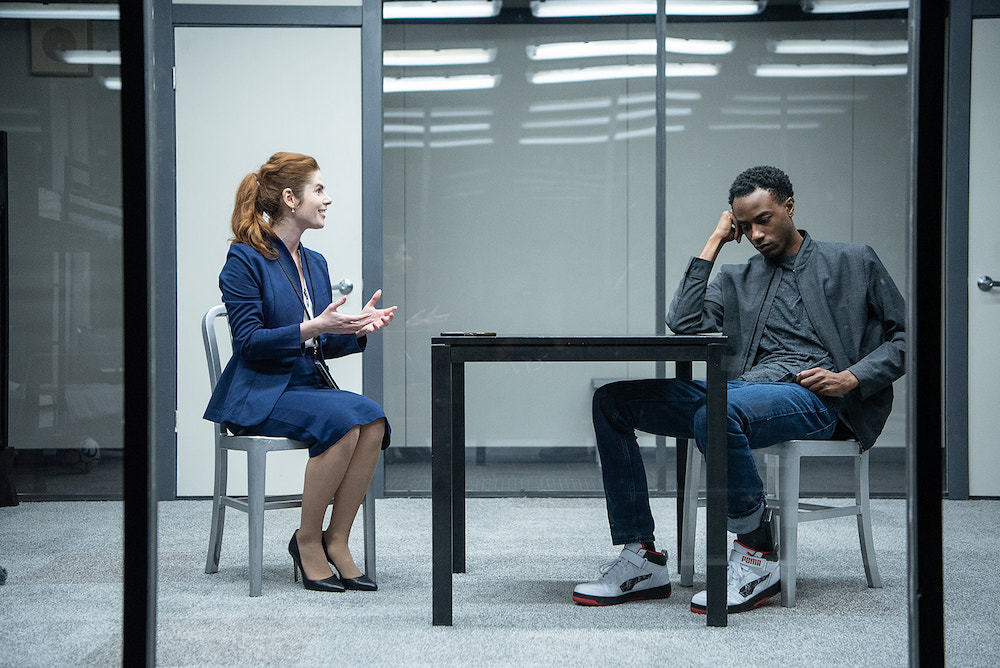
Home is where the heart is, the proverb says—and home is the heart of the story in Routes, a British play now being staged by Remy Bumppo Theatre Company. The play is a US premiere, directed by Mikael Burke, written by Rachel De-lahay and first staged in London in 2013. It’s a story of immigrants and refugees seeking a home and is, of course, as relevant here now as it was in the UK nine years ago and still is today. Both countries have a troubled history with their treatment of refugees and immigrants.
De-lahay’s script, which is divided into a couple of dozen individual scenes, creates a moving portrait of two people desperate to settle in a place they can call home. But the brief and sometimes rushed scenes, and an abrupt ending, give the work a feeling of irresolution. I had a sense that Routes is still a work in progress.
The story is set in two countries where two men are determined to either emigrate to England or stay there. In Nigeria, Olufemi (Yao Dogbe) works with Abiola (Kevin Tre’von Patterson) to obtain an expensive fake passport that will allow him to move to England to be with his family. In England, Bashir (Terry Bell), a teenaged orphaned Anglo-Somali, is desperate to stay in England, where he has lived his whole remembered life, rather than being sent to war-torn Mogadishu because of a problem with his immigration status. Kola (TJ Thomas), his roommate in the detention center, is English and spars with his mom, about whether he can still live at home or should be out on his own. His mom, Lisa (Kristin E. Ellis), is an immigration officer who interviews Olufemi when he arrives in the UK. In addition, an immigration volunteer, Anka (Evelyn Lockley) works with Bashir to try to help him iron out his desperate status.

Instead of being staged as separate scenes, Burke’s staging has the pairs overlapping each other’s scenes, sometimes with one character lingering in the same brightly lighted room in which another pair is conversing. This braiding of scenes emphasizes the immigrant relationships and futility questions of both Olufemi and Bashir.
The play is set in a glass-enclosed cell/office/dormitory room and the audience views the play through a fourth wall of glass. Individual scenes start with a lighting change and are marked by an institutional clang. The scenic design by Mara Zinky (lighting by Eric Watkins and sound by Peter Clare) creates a sense of distance that does not help us connect with the characters. The play runs just 80 minutes and ends abruptly, suggesting its unfinished nature and perhaps the uncertain future of that search for home. .
Bell and Dogbe as Bashir and Olufemi both give estimable performances as people frantically trying to keep their lives on track, despite the whims of governmental edicts. The rest of the cast is solid as well.
Despite the horrific nature of the story for its two main protagonists, there are some humorous lines, which the audience roared at. But as the story moved toward its inevitable ending, the theater grew silent.
Routes was first produced st the Royal Court Theatre in London and won De-lahay an Evening Standard award for Most Promising Playwright. Her first play, The Westbridge, also was staged at the Royal Court. She frequently writes for TV and film.
Routes by Remy Bumppo Theatre continues through November 20 at Theater Wit, 1229 W. Belmont Ave. Tickets are $32-$40 for performances Thursday-Sunday. Theater Wit requires that audience members wear masks while in the theater, but they are not required in the lobby.
